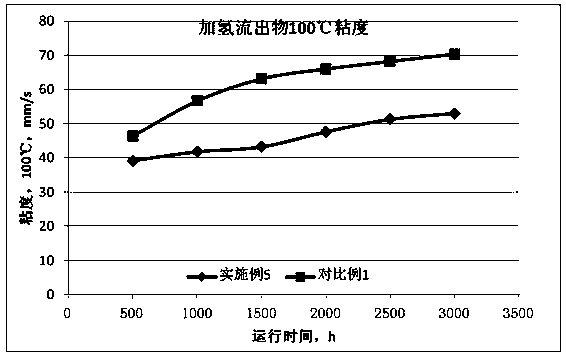Method for removing metal impurities in residual oil through hydrogenation
A hydrodemetallization and demetallization technology, applied in hydrotreating process, refining to remove heteroatoms, petroleum industry, etc., can solve the problems of high viscosity, complex process, high density of heavy fractions, etc.
- Summary
- Abstract
- Description
- Claims
- Application Information
AI Technical Summary
Problems solved by technology
Method used
Image
Examples
preparation example Construction
[0064] In the method for removing metal impurities in residual oil by hydrogenation of the present invention, the preparation method of the first hydrodemetallization catalyst can be prepared by a conventional method, preferably by the following method, specifically including:
[0065] (1) Dry the woody raw material and crush it into sawdust;
[0066] (2) Selectively adding hydrogenation active metal components to the sawdust and pseudo-boehmite obtained in step (1), kneading and extruding;
[0067] (3) Perform microwave pretreatment on the molded product obtained in step (2) at 200~350°C, the pretreatment time is 0.5~5.0h, and the microwave power is 1~6kW; The temperature is 400~600℃, and the carbonization time is 0.5~8.0h;
[0068] (4) Activate the material after carbonization in step (3) at 500-800°C for 1-5 hours at high temperature, the activation atmosphere is an alkaline gas atmosphere, and after activation, selectively introduce hydrogenation active metal components t...
Embodiment 1
[0079] The sawdust was dried at 140°C for 5 hours and crushed into 200-mesh sawdust; the sawdust was mixed with pseudoboehmite with a particle size of 110 μm in 2 o 3 Mix according to the mass ratio of 3:7, and add 5wt% acetic acid, 3wt% kale powder and a solution containing active metal components molybdenum and nickel, knead, and then extrude; the extrudate is microwaved at 250 ° C Pretreatment for 1 hour with a microwave power of 2kW, followed by carbonization for 3 hours in an inert gas atmosphere at a carbonization temperature of 450°C; the carbonized carrier was activated at a high temperature at 700°C, and the activation atmosphere contained ammonia water with a volume fraction of 5% Steam, activation time 3h, prepared the first hydrodemetallization catalyst A of the present invention, the properties of the catalyst are shown in Table 1.
Embodiment 2
[0081] Compared with Example 1, the difference is that the sawdust was dried at 110°C for 7 hours, crushed into 250 mesh wood chips, the microwave pretreatment temperature was 300°C, the microwave power was 4kW, and the activation atmosphere contained 15% ammonia water vapor by volume fraction , the activation time was 2h, and the others were the same as in Example 1 to prepare the first hydrodemetallization catalyst B of the present invention. The properties of the catalyst are shown in Table 1.
PUM
| Property | Measurement | Unit |
|---|---|---|
| Granularity | aaaaa | aaaaa |
| Particle size | aaaaa | aaaaa |
| Granularity | aaaaa | aaaaa |
Abstract
Description
Claims
Application Information
 Login to View More
Login to View More - R&D
- Intellectual Property
- Life Sciences
- Materials
- Tech Scout
- Unparalleled Data Quality
- Higher Quality Content
- 60% Fewer Hallucinations
Browse by: Latest US Patents, China's latest patents, Technical Efficacy Thesaurus, Application Domain, Technology Topic, Popular Technical Reports.
© 2025 PatSnap. All rights reserved.Legal|Privacy policy|Modern Slavery Act Transparency Statement|Sitemap|About US| Contact US: help@patsnap.com



